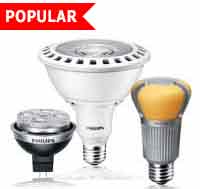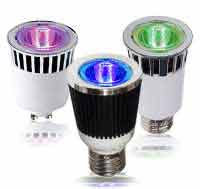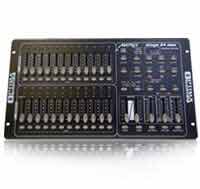In the Spotlight #7: Choosing the Right CFL Shape
By BulbAmerica Editor
 As CFLs become the go-to replacement for incandescent bulbs, they continue to multiply in the number of shapes they are offered in. What shape should you choose and why? These are good questions and in this article I will answer them for you, so let’s get started. CFL shapes can be broken down into two general shape categories, open shape CFLs and closed shape CFLs. Open CFLs refer to CFLs where the glass envelope is plainly visible such as in twists, mini-twists, and triple tube lamps. Closed CFL bulbs refer to CFLs where the envelope is concealed by another envelope such as with A-shape CFLs, globes, candelabras, bullets, and others.
As CFLs become the go-to replacement for incandescent bulbs, they continue to multiply in the number of shapes they are offered in. What shape should you choose and why? These are good questions and in this article I will answer them for you, so let’s get started. CFL shapes can be broken down into two general shape categories, open shape CFLs and closed shape CFLs. Open CFLs refer to CFLs where the glass envelope is plainly visible such as in twists, mini-twists, and triple tube lamps. Closed CFL bulbs refer to CFLs where the envelope is concealed by another envelope such as with A-shape CFLs, globes, candelabras, bullets, and others.
The criteria you should use for deciding between closed and open shape CFL is the bulb’s application. Are you going to be using it in an enclosed fixture or in a partially exposed application like in certain wall sconces? For enclosed fixtures, most people go with open CFLs for two predominant reasons. The first is that open CFLs, such as mini-twists are often less expensive and less appealing to look at than closed bulbs, so people try to use them wherever they can get away with it. Furthermore, closed CFLs are often enclosed in an additional frosted glass envelope, further diffusing the light. Enclosed fixtures often come with frosted plastic or glass diffusers, therefore by using an A-shape CFL, or other such closed CFL, in an enclosed fixture you could be softening the light excessively or simply using redundant diffusers and wasting money. Put simply, my rule of thumb is that forclosed fixtures use open CFLs, and for open fixtures use closed CFLs. This should give you the light bulb and light you want.
When it comes to choosing between the different open CFL bulbs, you’ll again, want to take application into consideration. For lamps with shades, you’ll likely want to choose an open CFL with a smaller, more slender profile, such as a quad or triple tube bulb or a mini-twist. For larger fixtures, twist bulbs are a good choice. Similar considerations should be made when choosing among closed CFLs. Globe and Candelabra CFLs are typically used in more decorative or specialty applications like bathroom lighting or wall sconces, where the shape of the bulb itself is important. A-shape bulbs are good in many applications. Don’t forget about closed R (reflector) or BR (bulge reflector)bulbs either, they are typically used in recessed applications or ceiling fan fixtures. Hopefully this guide has been helpful and will assist you in navigating the numerous CFL shapes available.
Don’t forget to make BulbAmerica your one stop shop for CFLs. No matter what CFL you need, we’ve got it! As usual, leave us a comment or question on our blog or our Facebook. Also don’t forget to give us a call at (888)505-2111 with any further inquiries you have.



















 Air purifiers a great way to get rid of odors in your home or office. Unfortunately, they can be both cumbersome and expensive. Sunlite has recently come up with an inexpensive and compact solution, a compact fluorescent solution to be exact, to this problem. Sunlite’s O-ZONElite is a CFL twist bulb, available in 23w and 42w versions, coated with titanium oxide which is activated in a photocatalytic reaction as light passes through it. This reaction eliminates odors, bacteria, and fungi in rooms up to 10ft X 10ft.The O-ZONElite is a great choice in bathrooms, kitchens, bedrooms, basements, smoking rooms, and other spaces that are frequently exposed to odors, germs, and bacteria. With the Sunlite O-ZONElite, you are not only getting an odor/bacteria remover, but you are also getting a high quality
Air purifiers a great way to get rid of odors in your home or office. Unfortunately, they can be both cumbersome and expensive. Sunlite has recently come up with an inexpensive and compact solution, a compact fluorescent solution to be exact, to this problem. Sunlite’s O-ZONElite is a CFL twist bulb, available in 23w and 42w versions, coated with titanium oxide which is activated in a photocatalytic reaction as light passes through it. This reaction eliminates odors, bacteria, and fungi in rooms up to 10ft X 10ft.The O-ZONElite is a great choice in bathrooms, kitchens, bedrooms, basements, smoking rooms, and other spaces that are frequently exposed to odors, germs, and bacteria. With the Sunlite O-ZONElite, you are not only getting an odor/bacteria remover, but you are also getting a high quality  Compact fluorescent light (CFLs) bulb technology
Compact fluorescent light (CFLs) bulb technology In the past,
In the past,  Recently great progress has been made in the development of environmentally friendly and efficient light bulbs to replace the traditional incandescent bulb. The compact fluorescent bulb (CFL) and the
Recently great progress has been made in the development of environmentally friendly and efficient light bulbs to replace the traditional incandescent bulb. The compact fluorescent bulb (CFL) and the  Today, homeowners and business owners alike are always on the look out for ways to save energy and save on their energy expenses. Many people look to the latest and greatest in
Today, homeowners and business owners alike are always on the look out for ways to save energy and save on their energy expenses. Many people look to the latest and greatest in 





Stay in Touch